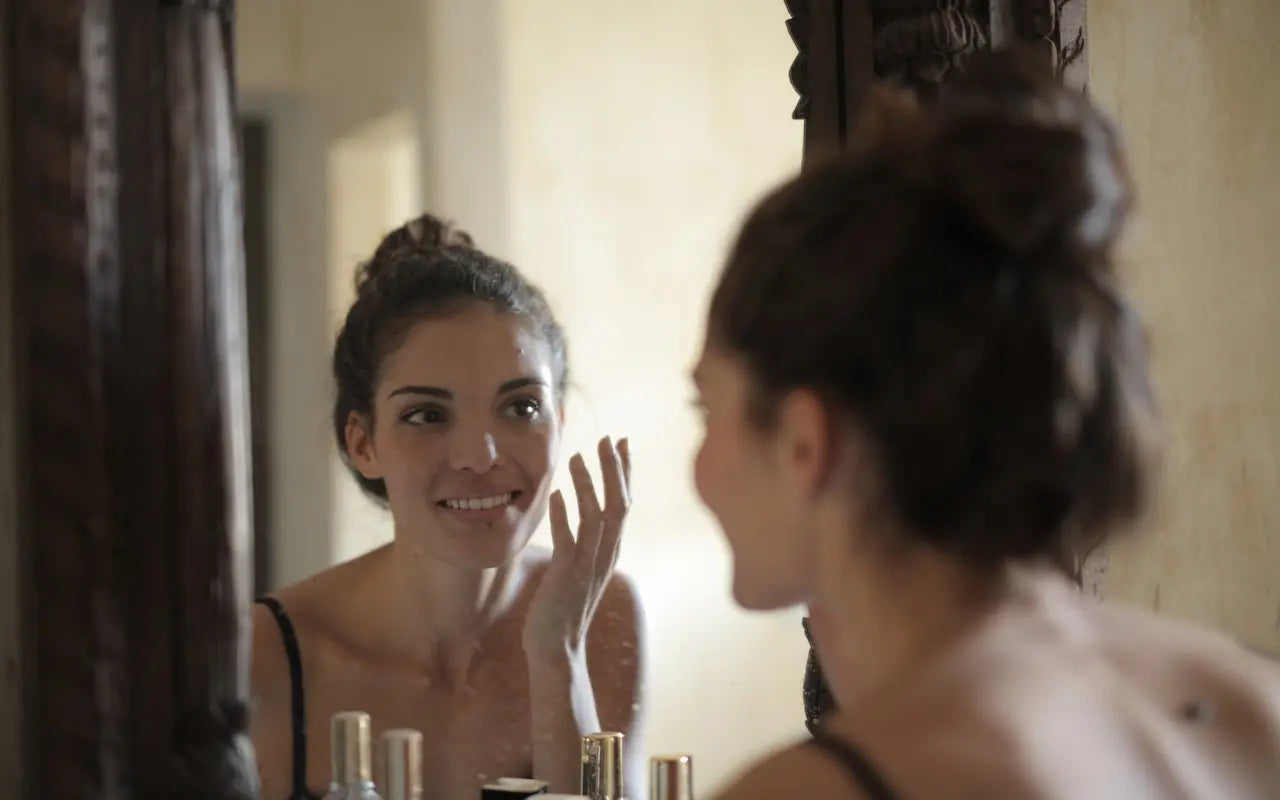Medically Reviewed by Dr. Lisa Hartford, MD
Sun damage goes beyond tanned skin and rosy cheeks. It changes the skin at the DNA level and causes the collagen in the skin to break. With constant sun exposure, the skin will develop fine lines, wrinkles, sun spots, and hyperpigmentation.
In addition, chronological aging may not be able to completely undo the sun damage on its own. Factors such as aging, environmental stress, lifestyle, and lack of skin care contribute to long-lasting damage.
It is highly important to manage skin aging and sun damage with the right therapies and skin care. Keep reading to learn how LED therapy may be your one-stop solution for reversing aging and sun damage.
Impact of Sun Damage on the Skin
Sun damage is inevitable as the UV rays penetrate deep inside the skin, causing the DNA to change and the skin to develop aging signs. When UV rays enter skin cells, they cause the skin to darken and lose structure by affecting the collagen. Over time, the skin may look thin, wrinkled, and leathery due to excessive sun exposure.

Apart from this, sun damage can cause hyperpigmentation, early wrinkles, sun spots, and hives. Photoaging due to the sun may affect the skin structure permanently. Within just five to ten minutes of unprotected UV exposure, the skin cells start to experience a change in balance.
UV aging is different from chronological aging. The natural aging process of the skin depends on genetics, gender, and cell metabolism. On the other hand, photoaging is due to the sun exposure.
Another difference is that photoaging occurs on the exposed parts of the skin, and chronological aging can be seen in non exposed places of the skin.
The only way to prevent sun damage is to not step out in the sun without UV protection. In addition, minimize sun exposure during peak hours of the day.
Who’s more likely to get sun damage: Some people are more susceptible to getting sun damage than others. For instance, light skin tans/burns faster than darker skin due to the absence of melanin. This also causes more wrinkles in lighter skin.
Those who spend more time working outdoors in the sun or travel to high altitudes may get more sun damage. If your skin burns before it tans, it will get more damaged.
Can sun damage be reversed?
As we discussed earlier, the sun’s UV rays lead to DNA damage. Once this DNA damage occurs, the skin undergoes irreparable damage. However, the impact on the appearance of the skin may be reduced with the right skincare and interventions.
One way to treat the skin is to stimulate collagen, fibroblast, and endothelial growth factor. This may aid in reducing the appearance of wrinkles, fine lines, and sunspots.
What is the Endothelial Growth Factor?
Vascular endothelial growth factor(VEGF) is termed as an angiogenic(related to blood vessels) factor essential for endothelial cell growth. Its function is to stimulate the growth of new blood vessels to repair skin at the time of injury or natural degradation. Moreover, it may create new vessels to remove blocked vessels, delivering nutrients, blood, and oxygen to the cells.
VEGF is an extremely important proangiogenic molecule that is present abundantly in the skin. Not only does it heal wounds and generate blood vessels, but it also supports hair growth.
When the skin cells need to regenerate at the wound site, VEGF helps in processes such as proliferation, migration, differentiation, and survival. This process starts at the embryonic stage and lasts the whole life.
The healing may also be required as the skin ages and goes through environmental impact every day. By releasing VEGF mRNA44 and protein in wound fluid, it heals the cell while producing new blood vessels.
Many studies have been done to learn more about this phenomenon. Human cell wounds receive VEGF from the keratinocytes in both the early and later stages of the wound healing process. This also triggers the fibroblasts, mast cells, and macrophages to heal the impacted skin.
As we age, the VEGF and fibroblast activity may be reduced. Due to this, the skin may experience delays in wound closure and reduced vessel density. Besides, the cells may not be able to receive appropriate oxygen with a lack of blood vessels.

Therefore, effective and non-invasive interventions may be needed to ensure endothelial growth factors are able to function. Retaining healthy skin and integrity is the end goal for many. Supported by epidermal stem cells, the skin renews and regenerates throughout the course of time.
When these stem cells are immobilized or reduced in numbers, the number of regenerated cells also decreases. This is when the aging process starts gradually, resulting in sun spots, tissue damage, muscle losing strength, and skin sagging.
To ensure the skin regenerates at a proper rate, it is important to trigger fibroblast activity and endothelial growth factors. As the new blood vessels and capillaries form, the reepithelialization will begin where fibroblasts have migrated.
LED Therapy to Promote Endothelial Growth Factor
There is substantial scientific evidence pointing towards the efficacy of LED therapy for endothelial growth factors. In simple terms, different light colors have varying wavelengths, which are able to penetrate inside the dermis. For instance, red LEDs can penetrate up to 4-5 mm, triggering collagen generation.
This allows the light to reach mitochondria and provides more energy for cell regeneration and synthesis. In a recent study, low light level therapy(LLLT) was used in vivo to investigate the effects of light therapy by light-emitting diodes of different wavelengths on endothelial cells in vitro.
Human vein endothelial cells were exposed to different wavelengths of 475 nm, 516 nm, and 635 nm light. Scientists used manual counting to learn about the 2D proliferation of cells. Moreover, a 3D bead assay and fibrin co-culture model were used to check the influence of LLLT on early vasculogenic activity.
In the results, the stimulation with both red and green LED lights increased HUVEC proliferation and 3D migration. Moreover, HUVEC led to a rise in 2D migration potential with green light stimulation. We can conclude that different wavelengths of light and help in tissue regeneration induce intracellular mechanisms.
Delving Into At-Home LED Mask Therapy
To receive professional treatment at home, you need to invest in a premium device that is safe to use. We suggest using the EvenSkyn Mirage Pro LED Phototherapy Face Mask to get the benefits of LED face therapy.
The mask is certified by the FDA, Health Canada, CE, RoHS, BSCI, and ISO13485, so you can treat your skin safely at home. With 204 powerful LEDs, the mask offers photobiomodulation therapy capable of treating photoaged skin.

What makes the mask super effective is the 500 joules of energy release. You can use the red, blue, and yellow LEDs of the mask to rejuvenate the skin. The red LED will produce collagen in the skin, triggering endothelial growth factor.
Additionally, blue light may help in managing acne by reducing bacteria on the skin. Lastly, with yellow light, you can rejuvenate old skin cells and bring radiance back. The mask adjusts snugly to the face while also offering in-built eye protection.
You may use one color LED and adjust its intensity with the remote. Another effective way of using the mask is to select the automatic feature where all the colors are cycled to rejuvenate the skin.
Parting Words
Sun damage may be hard to escape; however, we can manage to reverse it with the right approach. With the use of photobiomodulation LED therapy, endothelial growth factors can be stimulated to improve fibroblast activity. This can help in regenerating the depleting collagen.
When using LED therapy, maintain consistency as the changes occur at the cellular level and take some time to be visible. With consistency, you may notice a change in your skin’s appearance and texture.
In addition to LED therapy and the right skin care, it’s important to minimize sun exposure. You may use protective clothing and sunblock to protect the skin when stepping out during the day.
References:
- Mehrabani D, Manafi N. “Role of cultured skin fibroblasts in aesthetic and plastic surgery.” World J Plast Surg. 2013 Jan
- Rohringer S, Holnthoner W, Chaudary S, Slezak P, Priglinger E, Strassl M, Pill K, Mühleder S, Redl H, Dungel P. “The impact of wavelengths of LED light therapy on endothelial cells.” Sci Rep. 2017 Sep 6
- Heiskanen V, Hamblin MR. “Photobiomodulation: lasers vs. light emitting diodes?” Photochem Photobiol Sci. 2018 Aug 8
- Gold MH, Andriessen A, Biron J, Andriessen H. “Clinical Efficacy of Self-applied Blue Light Therapy for Mild-to-Moderate Facial Acne.” J Clin Aesthet Dermatol. 2009 Mar
- Opel DR, Hagstrom E, Pace AK, Sisto K, Hirano-Ali SA, Desai S, Swan J. “Light-emitting Diodes: A Brief Review and Clinical Experience.” J Clin Aesthet Dermatol. 2015 Jun
- Efstathios Giannakopoulos, Annita Katopodi, Michail Rallis, Konstantinos Politopoulos & Eleni Alexandratou. “The effects of low power laser light at 661 nm on wound healing in a scratch assay fibroblast model.” December 2022
- Wunsch A, Matuschka K. “A controlled trial to determine the efficacy of red and near-infrared light treatment in patient satisfaction, reduction of fine lines, wrinkles, skin roughness, and intradermal collagen density increase.” Photomed Laser Surg. 2014 Feb
- Wong QYA, Chew FT. “Defining skin aging and its risk factors: a systematic review and meta-analysis.” Sci Rep. 2021 Nov
- Alberts B, Johnson A, Lewis J, et al. “Molecular Biology of the Cell.” 4th edition. New York: Garland Science; 2002









Leave a comment
All comments are moderated before being published.
This site is protected by hCaptcha and the hCaptcha Privacy Policy and Terms of Service apply.